How to Skim for Main Ideas
Skimming is a speed reading strategy used as either a pre-reading technique to familiarize yourself with expository reading text before you read in depth or as an end in itself to quickly comprehend the essentials of a reading passage.
As a pre-reading technique, skimming helps to connect the text with any prior knowledge of the reader. Skimming also helps the reader to access the story schema so as to provide a referential context for the reading. In other words, skimming helps the reader to learn in advance what the gist of the reading passage is, while reminding the reader of any background information and knowledge of how the writing is organized that will assist the reader in understanding the text. Used as a pre-reading technique, skimming helps prepare the reader for scanning (reading at 50% comprehension) or further in-depth reading.
As an end in itself, skimming is a very practical and useful skill. As a speed reading technique, it saves time and allows the reader to get the flavor of a reading passage without all of the details. Skimming also permits broader reading, if time is a factor. For example, a reader can certainly skim many articles in the daily newspaper in the time that it might take to fully read a few. Many books can be skimmed for enjoyment or information now and then read later at a more leisurely rate.
To skim, readers should first search for the expository text clues and signposts for key ideas of the reading passage. Textbooks usually provide important study helps that can build comprehension. The unit and chapter titles give information as to the overall focus of the reading passage. Many times, key chapter ideas are listed in bulleted form or as key questions. In social studies texts, timelines are often helpful.
Next, read the first paragraph of the text. The first paragraph frequently provide an introduction of the chapter main ideas.
Then, read the subtitles and bold print of key terms throughout the reading selection. These act as newspaper headlines to tell the “Who,” “What,” “Where,” “When,” and “Why” of the reading. Graphics, such as pictures, photographs, charts and drawings are particularly important to examine. Indeed, “a picture can be worth a thousand words.”
Finally, read the concluding paragraph(s) or summary. This paragraph(s) will emphasize the key concepts.
Use these expository text clues or signposts for effective skimming. This speed reading technique is well worth practicing to perfection.
*****
The Science of Reading Intervention Program
The Science of Reading Intervention Program: Word Recognition includes explicit, scripted instruction and practice with the 5 Daily Google Slide Activities every reading intervention student needs: 1. Phonemic Awareness and Morphology 2. Blending, Segmenting, and Spelling 3. Sounds and Spellings (including handwriting) 4. Heart Words Practice 5. Sam and Friends Phonics Books (decodables). Plus, digital and printable sound wall cards and speech articulation songs. Print versions are available for all activities. First Half of the Year Program (55 minutes-per-day, 18 weeks)
The Science of Reading Intervention Program: Language Comprehension resources are designed for students who have completed the word recognition program or have demonstrated basic mastery of the alphabetic code and can read with some degree of fluency. The program features the 5 Weekly Language Comprehension Activities: 1. Background Knowledge Mentor Texts 2. Academic Language, Greek and Latin Morphology, Figures of Speech, Connotations, Multiple Meaning Words 3. Syntax in Reading 4. Reading Comprehension Strategies 5. Literacy Knowledge (Narrative and Expository). Second Half of the Year Program (30 minutes-per-day, 18 weeks)
The Science of Reading Intervention Program: Assessment-based Instruction provides diagnostically-based “second chance” instructional resources. The program includes 13 comprehensive assessments and matching instructional resources to fill in the yet-to-be-mastered gaps in phonemic awareness, alphabetic awareness, phonics, fluency (with YouTube modeled readings), Heart Words and Phonics Games, spelling patterns, grammar, usage, and mechanics, syllabication and morphology, executive function shills. Second Half of the Year Program (25 minutes-per-day, 18 weeks)
The Science of Reading Intervention Program BUNDLE includes all 3 program components for the comprehensive, state-of-the-art (and science) grades 4-adult full-year program. Scripted, easy-to-teach, no prep, no need for time-consuming (albeit valuable) LETRS training or O-G certification… Learn as you teach and get results NOW for your students. Print to speech with plenty of speech to print instructional components.
SCIENCE OF READING INTERVENTION PROGRAM RESOURCES HERE for detailed product description and sample lessons.
Get the SCRIP Comprehension Strategies FREE Resource:
Get the Diagnostic ELA and Reading Assessments FREE Resource:
Get the Syllable Awareness Assessment FREE Resource:
Get the SCRIP Comprehension Strategies FREE Resource:
![]()
Get the Diagnostic ELA and Reading Assessments FREE Resource:
Literacy Centers, Reading, Spelling/Vocabulary, Study Skills

